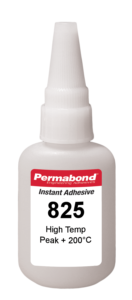Why are some adhesives listed as high temperature resistant when they resist only 150°C, while others are classified as high temperature resistant and resist 300°C or more? The classifications are based on what typical temperature resistance is for that technology. For example, a standard anaerobic threadlocker resists 150°C, so a threadlocker that resists 230°C is a high-temperature resistant threadlocker. At the same time, standard ethyl-based cyanoacrylates resist 82 °C, whereas some specialty grades can withstand 250°C.
Organic adhesives such as cyanoacrylate, epoxy, acrylic, anaerobic, and UV curable acrylates will break down around 250, and 300°C. Where inorganic-based adhesives such as ceramic threadlockers can resist up to 650°C and silicone based can exceed 350°C.
The ability of the adhesive itself to resist breakdown due to high temperature is only one facet of a complex set of conditions. Adhesives can soften as temperature increases. This can be an added benefit as they absorb stresses related to differential coefficients of expansion and contraction. However, when designing with heat-resistant adhesives for high-temperature applications, it is best to test the joint strength at the required temperature. This is often listed as Hot Strength.
The service temperature listed for the adhesive is a guide. The factors affecting the actual service temperature of anyone bonded joint include:
Most heat resistant adhesives can resist higher temperatures than what is listed as the service temperature for short periods of time, providing adhesion to the substrate is high and the stress is low.
Many applications require the joint to be repeatedly heated and cooled. When two components, joined by mechanical means, experience thermal cycling micro cracking or stress fractures can form in the substrates. Therefore, adhesives that absorb stress can eliminate the breakdown of the substrates. Many adhesives designed to resist thermal cycle have higher degrees of flexibility. This consequently helps absorb the stresses related to the two components’ expansion and contraction.
The rate at which the temperature change occurs can be a large factor in how successful the bond is at resisting failure. Thermal shock is a very fast change in temperature.
For further help and advice on heat resistant adhesives, please contact Permabond.
